
A multiple rocket launcher (MRL) or multiple launch rocket system (MLRS) is a type of rocket artillery system. Rockets have different capabilities than artillery, like longer range and different payloads, typically considerably larger warheads than a similarly sized artillery platform or multiple warheads. Unguided rocket artillery is notoriously inaccurate and slow to reload compared to artillery. To overcome this rockets are combined in systems that can launch multiple rockets simultaneously. Modern rockets can use GPS or inertial guidance to combine the advantages of rockets with high accuracy.

The GC-45 is a 155 mm howitzer designed by Gerald Bull's Space Research Corporation (SRC) in the 1970s. Versions were produced by a number of companies during the 1980s, notably in Austria and South Africa.

The Royal Ordnance L7 is the basic model of the United Kingdom's most successful tank gun. The L7 is a 105 mm L/52 rifled design by the Royal Ordnance Factories intended for use in armoured fighting vehicles, replacing the earlier 20-pounder (84 mm) tank gun mounted on the Centurion tank. The successful L7 gun has been fitted on many armored vehicles including the British Centurion, the German Leopard 1 and early variants of the US M1 Abrams.
The 507th Maintenance Company was a United States Army unit which was ambushed during the Battle of Nasiriyah in the rapid advance towards Baghdad during 2003 invasion of Iraq on 23 March 2003. The most well known member of the unit was Private First Class Jessica Lynch whose rescue from an Iraqi hospital received world wide media coverage. Sergeant Donald Walters and Private First Class Patrick Miller were both awarded the Silver Star for valor. Sergeant Matthew Rose was awarded the Bronze Star Medal with "V" Device. Many other members of the unit were decorated as well, receiving the Bronze Star Medal, Purple Heart, and/or Prisoner of War Medal.

The 7.5 cm Pak 40 was a German 75 millimetre anti-tank gun developed in 1939-1941 by Rheinmetall and used during the Second World War. With 23,303 examples produced, the Pak 40 formed the backbone of German anti-tank guns for the later part of World War II, mostly in towed form, but also on a number of tank destroyers such as the Marder series.

The 3.7 cm Flak 18/36/37/43 was a series of anti-aircraft cannon produced by Nazi Germany that saw widespread service in the Second World War. The cannon was fully automatic and effective against aircraft flying at altitudes up to 4,200 m. The cannon was produced in both towed and self-propelled versions. Having a flexible doctrine, the Germans used their anti-aircraft pieces in ground support roles as well; 37 mm caliber guns were no exception to that. With Germany's defeat, production ceased and, overall, 37 mm caliber anti-aircraft cannon fell into gradual disuse, being replaced by the Bofors 40 mm gun and later, by 35-mm anti-aircraft pieces produced in Switzerland.

Trial and Error is a 1997 American comedy film directed by Jonathan Lynn and starring Michael Richards, Jeff Daniels and Charlize Theron. The film's plot concerns an attorney and his actor friend, who takes his place in court to defend the boss's hopelessly guilty relative.

The Ordnance BL 5-inch howitzer was initially introduced to provide the Royal Field Artillery with continuing explosive shell capability following the decision to concentrate on shrapnel for field guns in the 1890s.
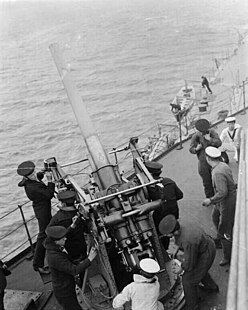
The QF 3 inch 20 cwt anti-aircraft gun became the standard anti-aircraft gun used in the home defence of the United Kingdom against German airships and bombers and on the Western Front in World War I. It was also common on British warships in World War I and submarines in World War II. 20 cwt referred to the weight of the barrel and breech, to differentiate it from other "3 inch" guns. While other AA guns also had a bore of 3 inches, the term "3 inch" was only ever used to identify this gun in the World War I era, and hence this is what writers are usually referring to by "3 inch AA gun".
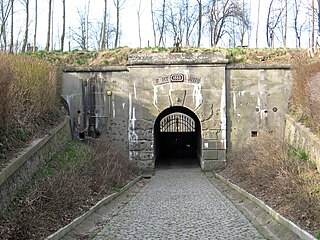
The Fort de Lantin is one of twelve forts built as part of the Fortifications of Liège in the late 19th century in Belgium. It was built between 1881 and 1884 according to the plans of General Henri Alexis Brialmont. Contrasting with the French forts built in the same era by Raymond Adolphe Séré de Rivières, the fort was built exclusively of unreinforced concrete, a new material, rather than masonry. The fort was heavily bombarded by German artillery in the Battle of Liège. Lantin was never upgraded like the other forts of Liège and retains its character as a Brialmont fort. It is preserved as a museum and may be visited by the public.

The Fort de Hollogne is one of twelve forts built as part of the fortifications of Liège in the late 19th century in Belgium. It was built between 1881 and 1884 according to the plans of General Henri Alexis Brialmont. Contrasting with the French forts built in the same era by Raymond Adolphe Séré de Rivières, the fort was built exclusively of unreinforced concrete, a new material, rather than masonry. The fort was heavily bombarded by German artillery in the Battle of Liège. Hollogne was never upgraded like the other forts of Liège and retains its character as a Brialmont fort. It is preserved as a museum and may be visited by the public.
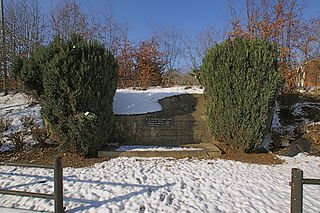
The Fort de Fléron is one of twelve forts built as part of the Fortifications of Liège in the late 19th century in Belgium. It was built between 1881 and 1891 according to the plans of General Henri Alexis Brialmont. Contrasting with the French forts built in the same era by Raymond Adolphe Séré de Rivières, the fort was built exclusively of unreinforced concrete, a new material, rather than masonry. The fort was heavily bombarded by German artillery in the Battle of Liège. Fléron was upgraded in the 1930s to become part of the fortified position of Liège in an attempt to forestall or slow an attack from Germany. Located in the center of Fléron, the fort has been buried and is surrounded by apartments.

The Fort de Barchon is one of twelve forts built as part of the Fortifications of Liège in the late 19th century in Belgium. It was built between 1881 and 1884 according to the plans of General Henri Alexis Brialmont. Contrasting with the French forts built in the same era by Raymond Adolphe Séré de Rivières, the fort was built exclusively of unreinforced concrete, a new material, rather than masonry. The fort was heavily bombarded by German artillery in the Battle of Liège. Barchon was upgraded in the 1930s to become part of the fortified position of Liège in an attempt to forestall or slow an attack from Germany. It saw action in 1940 during the Battle of Belgium, and was captured by German forces. It is preserved as a museum and may be visited by the public.

The Fort de Liers is one of twelve forts built as part of the fortifications of Liège in the late 19th century in Belgium. It was built between 1881 and 1884 according to the plans of General Henri Alexis Brialmont. Contrasting with the French forts built in the same era by Raymond Adolphe Séré de Rivières, the fort was built exclusively of unreinforced concrete, a new material, rather than masonry. The fort was heavily bombarded by German artillery in the Battle of Liège. Liers was never upgraded like the other forts of Liège. It is now used as a test site for aircraft engines and is not accessible to the public.
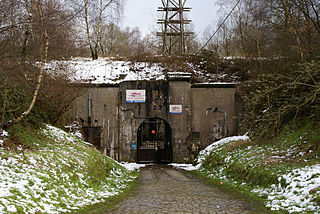
The Fort de Chaudfontaine, also called the Fort de la Rochette, is one of twelve forts built as part of the fortifications of Liège in the late 19th century in Belgium. It was built between 1881 and 1884 according to the plans of General Henri Alexis Brialmont. Contrasting with the French forts built in the same era by Raymond Adolphe Séré de Rivières, the fort was built exclusively of unreinforced concrete, a new material, rather than masonry. The fort was heavily bombarded by German artillery in the Battle of Liège. The fort is now used as an adventure park.

The Fort d'Embourg is one of twelve forts built as part of the fortifications of Liège in the late 19th century in Belgium. It was built between 1881 and 1884 according to the plans of General Henri Alexis Brialmont. Contrasting with the French forts built in the same era by Raymond Adolphe Séré de Rivières, the fort was built exclusively of unreinforced concrete, a new material, rather than masonry. The fort was heavily bombarded by German artillery in the Battle of Liège in World War I and again at the opening of World War II. It has been preserved and is operated as a museum.

Lützow was a heavy cruiser of Nazi Germany's Kriegsmarine, the fifth and final member of the Admiral Hipper class, but was never completed. The ship was laid down in August 1937 and launched in July 1939, after which the Soviet Union requested to purchase the ship. The Kriegsmarine agreed to the sale in February 1940, and the transfer was completed on 15 April. The vessel was still incomplete when sold to the Soviet Union, with only half of her main battery of eight 20.3 cm (8.0 in) guns installed and much of the superstructure missing.
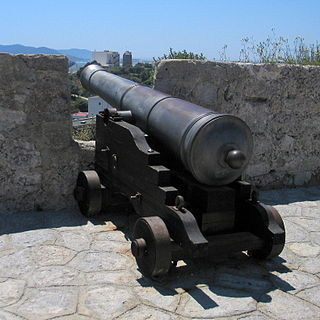
The 24-pounder long gun was a heavy calibre piece of artillery mounted on warships of the Age of sail, second only to the 36-pounder long gun. 24-pounders were in service in the navies of France, Spain, Great Britain, the Netherlands, Sweden, and the United States. They were comparable to the Canon de 24 Gribeauval used by the French Army as its largest piece of siege artillery. 24-pounders were used as main guns on the heaviest frigates of the early 19th century and on fourth-rate ships of the line, on the second deck of first-rate ships of the line, and on the second deck of a few large third-rates.

The 51st Guards Artillery Brigade is an artillery brigade of the Belarus Ground Forces, based at Osipovichi.

















